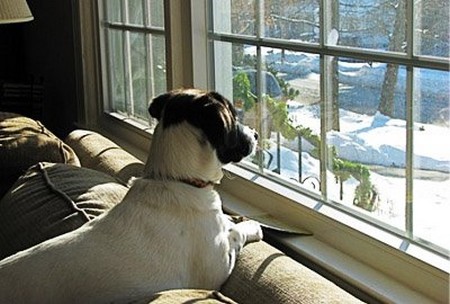Moms and their babies belong together. For most of us, it’s difficult to move our babies into their own beds or into their own rooms. There are several good books about helping your child get to sleep, which are really about helping your child separate from you, at least some of the time. I remember the wrenching feeling of listening to my baby cry and thinking, “She has to go through this,” even though all I wanted to do was to pick her up. Puppies have that same need for their mom’s presence and for the presence of their brothers and sisters. But they have to learn to be left alone, too, and it can be hard for both puppy and owner.
An observational study on the habits of wild dogs shows some interesting things parents do to prepare their pups for separation. This particular analysis observed a feral dog who changed dens weekly. She’d leave her puppies in the first home and go find another one. Then she’d move the puppies one by one to the new home. Each time she moved her puppies, she’d take a different puppy first (leaving him alone while she retrieved the second pup) and a different puppy last (so that pup was also left alone). This way the puppies learned that they could be alone and still be safe.
 Many excellent breeders will separate the puppies for a time every day when their eyes are open and they can respond to sounds. (This is the beginning of the socialization period.) They learn that they won’t be left alone for long and that their human or canine parent will return. However, some breeders don’t realize that this is necessary for a puppy’s development.
Many excellent breeders will separate the puppies for a time every day when their eyes are open and they can respond to sounds. (This is the beginning of the socialization period.) They learn that they won’t be left alone for long and that their human or canine parent will return. However, some breeders don’t realize that this is necessary for a puppy’s development.
Because many people think it’s cruel to separate puppies from one another and from their mother, you may discover that your puppy has had no experience with being left alone. It’s up to you to teach him, and you should start right away, but carefully.
To better prepare your new puppy for separation from you, his surrogate parent, try not to spend every waking minute with him. It’s tempting to play with your dog until he’s sleepy, and then do your chores when he’s napping. Instead, try putting him in a playpen (puppy pen) for a brief period every hour or so; help him learn that you will always return. He has not been abandoned after all! Starting off this way will prevent major separation problems later—and believe me, the problems can be horrendous. They can include massive destruction, whining, barking, crying, and escaping, and they are not simple to fix.
At night, if you don’t intend to have your adult dog sleep on your bed with you, then you should probably refrain from having your puppy do so. This doesn’t mean you have to relegate him to the garage (a place I very rarely recommend). Instead, put his bassinet— er, crate—right beside your bed. Give him a soft blanket to lie on, some stuffed toys, and help him settle down. If he cries a lot, try giving him a chew toy or treat dispenser with some puppy food in it. During the night, he may whimper. He will have to go potty in the middle of the night, and you should take him out, not put him out. If he cries when you put him back in the crate, putting your fingers through the bars often soothes him and makes him less lonely. The first night is usually the worst, so stick with it.